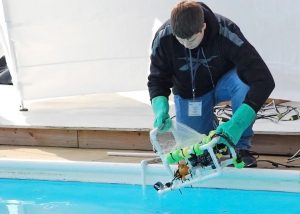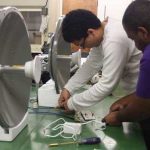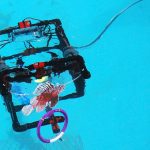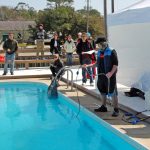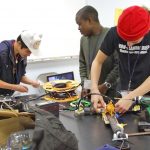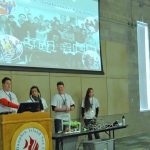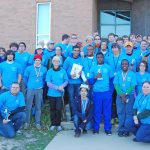Deep-C Technology Experiences Bring Science to Life for Students
– April 18, 2013
Technology plays a key role in oil-spill studies and GoMRI consortia researchers are involving students in the nuts and bolts (literally) of science, turning abstract concepts into real-word applications.
High school students are building remotely operated vehicles (ROVs) and competing with other high school teams. College engineering students are developing experimental radar systems and fabricating them in laboratories. And, scientists are helping to develop future careers that will grow knowledge about the Gulf of Mexico for generations.
Education specialists and scientists with the Deep Sea to Coast Connectivity in the Eastern Gulf of Mexico (Deep-C) research consortium have multi-year efforts working with K-12 teachers and students and with university students across their consortium.
At Dauphin Island Sea Lab (DISL) this March, teams from six high schools in Florida competed in the first annual Deep-C ROV student competition. The competition was the culmination of a workshop held last July that trained teachers to build ROVs. These teachers returned to their schools armed with new equipment and technical skills to direct their students in designing and developing their own robotic designs. The high-school student teams competed in a series of tasks, including one that tested the maneuverability of the vehicles and another that tested the operator’s ability to identify marine organisms through a mounted camera. After the competition, students presented their design process and answered questions from scientists and engineers about their projects. Watch a video of the 2013 Deep-C and DISL ROV Competition.
Dr. Tina Miller-Way, Chair of DISL’s Discovery Hall Programs for Education and Outreach, explained that ROV’s were chosen for this program because they have become an integral part of ongoing undersea research. She added, “ROVs are a great way to integrate technology, current Deep-C research and important concepts in STEM (science, technology, engineering and math) fields and also excite students.”
A group of undergraduate students from Florida A&M University and Florida State University (FSU) are working on a project to enhance oil spill detection. “This team of engineering seniors is fabricating an experimental radar unit that will be used to measure oil thickness under laboratory conditions,” explains Dr. Ian MacDonald, Professor of Oceanography in the Department of Earth, Ocean and Atmospheric Science at FSU and an advisor to the group. MacDonald describes the benefit of their work, “This will help to calibrate satellite measurements and could lead to the development of field instruments.”
Dr. Oscar Garcia-Pineda, a geophysicist at FSU and an advisor who works closely with the group further explains the importance of these students’ experiment, “The project has the potential to significantly improve coordinated response operations during an oil spill.” Dr. Garcia-Pineda explained that the ability to validate lab measurements with the satellite data could provide valuable information to crisis responders such as the U.S. Coast Guard and NOAA.
The Deep-C Coordinator Tracy Ippolito describes the inter-connectivity of Deep-C research and education, “The nature of the Deep-C project – the issues involved in understanding and protecting ecological communities in the Gulf of Mexico – provides rich opportunities for engagement with K-12 teachers and students and with college-level students.” Ippolito continues, “We can help promote science education in tangible ways, and share some of the wonder and awe of scientific discovery.”
Click on these links to read more about the Deep-C ROV Competition, the Experimental Radar Student Team, and about Deep-C research.
This research is made possible by a grant from BP/The Gulf of Mexico Research Initiative. The GoMRI is a 10-year, $500 million independent research program established by an agreement between BP and the Gulf of Mexico Alliance to study the effects of the Deepwater Horizon incident and the potential associated impact of this and similar incidents on the environment and public health.
- (Click to enlarge)
- (Click to enlarge)
- (Click to enlarge)
- (Click to enlarge)
- (Click to enlarge)
- (Click to enlarge)
© Copyright 2010- 2017 Gulf of Mexico Research Initiative (GoMRI) – All Rights Reserved. Redistribution is encouraged with acknowledgement to the Gulf of Mexico Research Initiative (GoMRI). Please credit images and/or videos as done in each article. Questions? Contact web-content editor Nilde “Maggie” Dannreuther, Northern Gulf Institute, Mississippi State University (maggied@ngi.msstate.edu).

